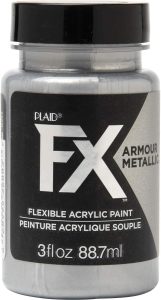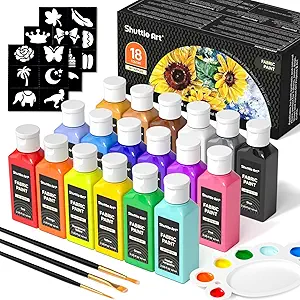The Best Paint for EVA Foam – A Complete Guide to Creating Perfect Cosplay and Prop Pieces
When working with EVA foam (Ethylene-Vinyl Acetate foam), whether for cosplay armor, props, or other creative projects, one of the most important considerations is how to paint the foam. EVA foam is lightweight, flexible, and durable, making it a fantastic material for cosplay and prop building, but without the right paint, the final result can look incomplete or unprofessional. The right paint can help your EVA foam projects achieve the realistic finish and durability you need.
We’ll go over the best paints for EVA foam, the preparation steps for painting, the types of paints to consider, and answer frequently asked questions to ensure your foam creations come out looking amazing.
Why Painting EVA Foam is Important
EVA foam on its own is often a dull color (typically black, white, or gray) and doesn’t have the sheen or finish needed to look like the high-quality props you see in movies or conventions. Applying the right paint not only enhances the visual appeal but also:
- Adds Depth and Detail: Paint can help create realistic textures and highlights, adding dimension to the foam.
- Improves Durability: The right paint protects the foam from wear and tear, ensuring that it holds up over time, especially in demanding cosplay environments or outdoor use.
- Helps with Finish: Whether you want a matte, glossy, or metallic look, paint allows you to customize the finish to match your design vision.
Types of Paint for EVA Foam
There are several types of paints you can use on EVA foam. However, not all paints are suitable for foam surfaces, so it’s essential to choose one that adheres well, maintains flexibility, and provides a smooth finish. Below are some of the most popular and effective types of paint used for EVA foam projects:
1. Acrylic Paint

Best for: Most EVA foam projects, especially for beginners and cosplayers.
Acrylic paint is one of the most popular and versatile options for painting EVA foam. It’s easy to use, dries quickly, and is available in a wide range of colors and finishes. When painting EVA foam, acrylic paint adheres well and can be thinned with water for a smoother finish.
Pros:
- Wide variety of colors and finishes.
- Dries quickly.
- Flexible and suitable for use on foam.
- Non-toxic and water-based.
Cons:
- Can crack or peel if not sealed properly.
- May require multiple coats for full coverage.
Recommended Brands:
- Apple Barrel Acrylic Paint
- FolkArt Acrylic Paint
- Liquitex Basics Acrylic Paint
2. Plasti Dip

Best for: Flexibility and durability for armor or prop builds.
Plasti Dip is a rubberized coating that provides flexibility, durability, and protection. It’s specifically designed to be used on foam and provides a more flexible finish than regular paints. Plasti Dip is particularly popular among cosplayers who make armor, props, or other items that need to bend and move without the paint cracking or peeling.
Pros:
- Provides a flexible, rubberized coating that moves with the foam.
- Excellent for larger pieces and armor.
- Offers a matte finish (other finishes available).
- Helps with waterproofing and protection.
Cons:
- Requires a bit of practice to apply evenly.
- Can take longer to dry and cure completely.
Recommended Brands:
- Plasti Dip Spray Paint
- Rust-Oleum Specialty Rubberized Coating
3. Spray Paint

Best for: Large EVA foam projects or when you need a smooth, even coat.
Spray paint is an efficient option for covering large surfaces or when you need a smooth, even layer on your EVA foam pieces. It’s fast-drying, provides even coverage, and is ideal for a quick application process. However, choosing a spray paint that adheres well to foam without causing it to melt or warp is essential.
Pros:
- Quick and easy to apply to large pieces.
- Provides smooth and even coverage.
- Ideal for both base coats and finishing touches.
Cons:
- Can be difficult to control on intricate pieces.
- Some spray paints may not bond well with foam without proper preparation.
- Can cause fumes and require good ventilation.
Recommended Brands:
- Krylon Fusion All-In-One
- Rust-Oleum Universal Spray Paint
- Montana GOLD Acrylic Professional Spray Paint
4. Fabric Paint

Best for: Soft, flexible EVA foam or detailed painting.
Fabric paint is another option for EVA foam projects, particularly if the foam will be flexing or bending often. While it’s not as commonly used as acrylic paint or Plasti Dip, fabric paint can be an excellent choice for creating smooth, durable finishes that can withstand the wear and tear of flexible foam. This paint type is made to be flexible and durable on fabrics but also works well on foam.
Pros:
- Flexible finish suitable for pieces that need to bend.
- Dries quickly and is durable.
- Non-toxic.
Cons:
- Limited range of colors and finishes compared to other paints.
- May require multiple coats for full coverage.
Recommended Brands:
- Tulip Fabric Paint
- FolkArt Fabric Paint
5. Vinyl Dye

Best for: High durability with long-lasting color.
Vinyl dye is a highly durable paint option that bonds well with foam and gives it a flexible finish. This paint is excellent for creating a long-lasting, vibrant color that won’t crack or peel over time. Vinyl dye is often used in automotive applications, but it’s also effective for EVA foam projects, especially those that require a glossy finish.
Pros:
- Provides a durable, flexible finish.
- Offers a professional, glossy look.
- Excellent for items that need to maintain their color over time.
Cons:
- Can be more challenging to apply than acrylic or Plasti Dip.
- Limited availability compared to other paints.
Recommended Brands:
- Dupli-Color Vinyl and Fabric Spray Paint
- SEM Products Vinyl Dye
Steps for Painting EVA Foam
To ensure your paint job on EVA foam lasts and looks fantastic, there are some important preparation steps to follow:
1. Prepare the Foam Surface
Start by cleaning the EVA foam. Dust, dirt, or oils from your hands can affect how the paint adheres to the surface. Use a clean, dry cloth or mild soap and water to wipe down the foam.
2. Seal the Foam
Before painting, sealing the foam is critical. Foam is porous, and without sealing, the paint may soak in, leading to uneven coverage and wasting a lot of paint. You can use a foam-specific sealer, like Plasti Dip or Mod Podge, or a DIY method like applying a thin layer of white glue (PVA) mixed with water. Let it dry completely before moving on to painting.
3. Apply the Base Coat
Once the foam is sealed, apply your base coat of paint. If using spray paint, hold the can 6-8 inches from the surface and spray in light, even coats. For acrylic paints, use a brush to apply smooth layers. You may need to apply two or three coats for even coverage, especially if you’re covering a light color with a darker one.
4. Detailing and Layering
Once the base coat is dry, you can add additional details, shading, or highlights. Use smaller brushes for intricate designs or layer different colors to achieve effects like weathering, aging, or shading.
5. Seal the Paint
After the paint has dried, seal your work with a clear acrylic sealer or varnish. This will protect the paint from chipping and ensure that it lasts throughout your cosplay event or display. You can choose between matte, satin, or glossy finishes depending on your desired effect.
Best Paints for EVA Foam at a Glance
| Paint Type | Best For | Pros | Cons |
|---|---|---|---|
| Acrylic Paint | General EVA foam projects | Variety of colors, dries fast, non-toxic | May require sealing, can crack if not set |
| Plasti Dip | Armor, props needing flexibility | Rubberized finish, flexible, durable | Takes time to cure, needs practice |
| Spray Paint | Large surface coverage, base coats | Smooth, even coverage, fast-drying | Hard to control on small details |
| Fabric Paint | Flexible foam pieces | Durable, flexible, fast-drying | Limited color range, multiple coats needed |
| Vinyl Dye | Long-lasting finish, high durability | Flexible, glossy, professional finish | Harder to apply, limited availability |
10 FAQs About the Best Paint for EVA Foam
1. Can I use normal spray paint on EVA foam?
No, regular spray paint may not bond well with EVA foam and can cause it to warp or melt. Use foam-safe spray paints like Krylon Fusion or Plasti Dip.
2. How do I prevent paint from cracking on EVA foam?
Seal the foam first to create a smooth surface, then use flexible paints like Plasti Dip or fabric paint to ensure that the paint moves with the foam without cracking.
3. How many coats of paint should I apply?
Typically, 2-3 coats of paint are sufficient for a solid finish. Make sure to let each layer dry completely before applying the next one.
4. Do I need to prime EVA foam before painting?
Yes, priming or sealing the foam before painting is crucial to ensure that the paint adher
es properly and provides even coverage.
5. Can I use acrylic paint for large EVA foam projects?
Yes, acrylic paint works well for both small and large EVA foam projects, but you’ll need to apply multiple coats for larger surfaces.
6. What is the best sealer for EVA foam?
Acrylic sealer, Mod Podge, or Plasti Dip are great options for sealing EVA foam. These help protect the paint and increase durability.
7. How long should I let the paint dry before handling the foam?
Allow at least 1-2 hours for the paint to dry, and 24 hours for it to fully cure before handling the foam.
8. Can I use fabric paint on EVA foam?
Yes, fabric paint is a great choice for flexible EVA foam, especially for pieces that need to bend or move.
9. How do I prevent paint from soaking into EVA foam?
Use a sealer before painting. This will prevent the foam from absorbing too much paint and will give you a smoother finish.
10. Is it safe to use Plasti Dip on EVA foam?
Yes, Plasti Dip is safe and specifically designed for use on foam. It provides a flexible, rubberized finish perfect for cosplay armor and props.
Conclusion
The best paint for EVA foam depends on the type of project you’re working on, the finish you want, and the flexibility required for the foam. From acrylic paints for general projects to Plasti Dip for armor, there are many excellent options to ensure your foam creations look great and last for years to come. By following proper preparation steps and using the right paint for your needs, you can achieve professional-looking results every time.


Leave a Reply